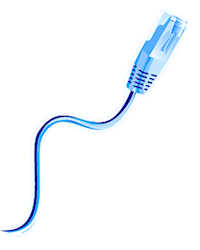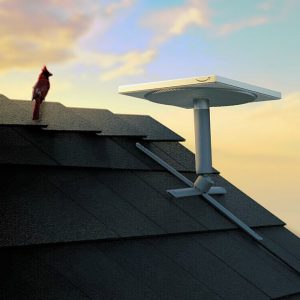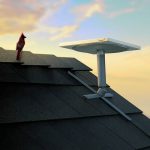
- Fixed Line Narrowband
- Fixed Line Broadband
- Wireless Broadband

On the surface this sounds ideal, especially with service speeds of up to c.100Mbps (Megabits per second) being available from some of the latest networks (Eutelsat, Starlink, OneWeb etc.), although there can also be some caveats to consider, depending upon the platform.
Satellite systems require the installation of a special receiving dish on your property (pictured top right), which isn't cheap and may in some areas cause a conflict with local planning permission (check with your council first). It's also not uncommon for hardware and setup fees to reach up to c.£500, but in other cases this may be covered by your monthly rental. Rental fees can vary but start at around £25-£30 per month.
In the current environment there tend to be two very different types of satellite platform, which also come with very different pros and cons.
1. Geosynchronous Equatorial Orbit (GEO) or Geostationary Satellites (GSO)This tends to reflect large - double-decker bus sized - communication satellites, such as Eutelsat's KA-SAT, Avanti's HYLAS or others from SES Astra that orbit high above the Earth at altitudes of about 35,000km+.
Such satellites can cost hundreds of millions to build, often only have limited capacity (this only improves as they're replaced over many years) and suffer from extremely slow latency times (e.g. 600-1000 milliseconds or worse). Network congestion, particularly at peak times, can also cause problems. Older platforms also suffer from meagre usage (data) allowances.
On the other hand, modern GEO/GSO broadband satellites can deliver fast download speeds and aren't as congested as older alternatives. For example, Eutelsat's KONNECT satellite can deliver speeds of up to 100Mbps (75Mbps average) and 5Mbps uploads (3Mbps average) for around £70 per month, with a £49.99 setup fee. Slower and cheaper plans are available.
One other benefit of GEO/GSO spacecraft is that they deliver coverage over an extremely wide area (e.g. one satellite may be able to cover the UK and most of Europe, as well as some of North Africa and the Middle East).
2. Low Earth Orbit (LEO)
Over the past few years' a new generation of compact LEO satellite has emerged via companies such as Starlink (SpaceX), OneWeb and Amazon (Kuiper) etc. Each one is roughly the size of a large suitcase (with solar panels folded-in) but, unlike those above, LEOs orbit much lower at altitudes of between 160 to 2000 kilometres (99 to 1200 miles).
At this height latency times can be much more akin to fixed line broadband connections (c.20-40ms), which provides for a much smoother experience. The catch is that you need hundreds, even thousands, of them to ensure good coverage and over time they will naturally (or intentionally) de-orbit to burn up in our atmosphere due to gravity. All of this makes them expensive to deploy, launch and run as a mega constellation (whether LEO or GEO/GSO, space is not cheap!).
However, aside from the latency advantages, large mega-constellations of LEOs could potentially deliver gigabit speeds to consumers in the future and have more scope for adapting to future capacity demands (i.e. greater numbers and rapid evolution). But some cost problems remain.
Starlink currently charges £89 per month for the service itself, plus £54 for shipping and £439 for the kit (dish, router etc.). For that you can expect unlimited usage, good latency times of 20-40ms, downloads of between 50-150Mbps and uploads of c.20Mbps. It's not cheap, but this is closer to a good fixed line service than you could expect from GEO/GSO satellites.
3. Medium Earth Orbit (MEO)
A third category also exists (MEOs), which typically sit in-between LEOs and GEO/GSOs. For example, OneWeb have plans to deploy 1,280 MEOs at 8,500km, which could introduce some global positioning technologies alongside broadband connectivity. At this height MEOs improve coverage (fewer platforms needed to cover the same area as LEOs), but they'll also suffer an impact to their latency times, albeit not as drastic as on GEO/GSOs.
With the exception of the aforementioned LEO constellations above, satellite services are generally no good for fast paced multiplayer gaming due to the time that it takes for signals to go from the Earth, to the satellite and then back down again (high latency). This, when combined with aggressive traffic limits and the use of NAT based IP addresses by some (but not all) providers, can also hinder the use of VPN, VoIP (Skype), IPTV and other latency-based internet services.
One challenge here is that, in order to compensate for the high cost of deploying satellite broadband services, operators often have to contend their capacity much more in order to make it affordable for consumers (i.e. sharing limited capacity between many users). Often this won't be a big problem when a new satellite or constellation launches, but over time it may creep in.
It's also important to recognise that some Satellite services are not able to allocate a UK based Internet Protocol (IP) address to your connection. As a result, that can make certain region-locked online services, such as TV content via the BBC's iPlayer, difficult to access. It might also result in Google returning search results for the wrong country, although that example is easy to fix.
- Good for general/basic internet use.
- Good download speeds, except on older platforms.
- Upload performance could be better.
- Poor usage allowances on older platforms.
- Slow latency performance on GEO/GSO.
Related ISPreview.co.uk Content:
* Broadband Satellite News
* Satellite ISP Listings
* Satellite ISP Reviews
* Satellite Discussion Forum








Latest UK ISP News
Helpful ISP Guides and Tips
- FTTP (6679)
- BT (3852)
- Politics (3019)
- Business (2714)
- Openreach (2613)
- Building Digital UK (2482)
- Mobile Broadband (2425)
- FTTC (2131)
- Statistics (2094)
- 4G (2052)
- Virgin Media (1986)
- Ofcom Regulation (1751)
- 5G (1680)
- Fibre Optic (1582)
- Wireless Internet (1578)
































